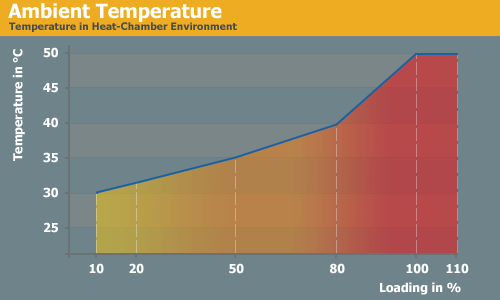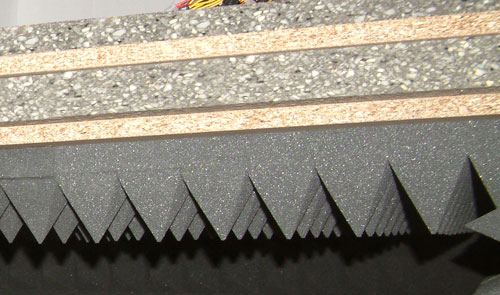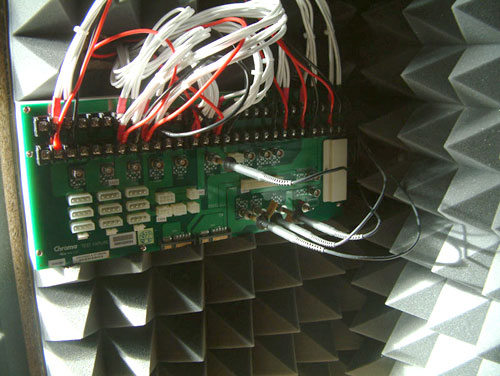Corsair TX750W Power Supply
by Christoph Katzer on October 30, 2008 3:00 AM EST- Posted in
- Cases/Cooling/PSUs
Testing with the Chroma ATE Programmable Load

Our test equipment consists of two Chroma programmable DC Loads that enable us to test power supplies with an output of up to 1500W. The biggest advantage of the Chroma DC Loads is simply the high precision it provides. It can measure differences as small as 0.001V and 0.0001A, which will provide us with best-in-class results.
When programming the Chroma with specific amounts of load calculated according to the ATX norm, we are able to load power supplies to an exact percentage. We can now show results at every specific percentage needed. To get the best overview of a power supply, we load each unit with 10%, 20%, 50%, 80%, 100%, and 110% of the specified output. This is easy to calculate for a 1000W power supply: the 10% load is 100W and 110% load is 1100W. Remember that this is the amount of power the PSU delivers; due to inefficiencies, a power supply will actually draw more power from the wall.
Note: If you would like to know more about our testing methodology, equipment, and environment, please read our PSU testing overview.
We have added an additional 10% on the highest load to see how the units perform with overload. This test will be performed in all future reviews. The overload test is performed at room temperature as well as under more stressful conditions; to ensure we are not too cruel to the power supplies, we will keep the ambient temperature at 50°C in the stress test. Experience shows that many units can stand the overload at room temperature but will experience problems with higher temperature and overload together. Only the best-built units will survive this.

The Testing Environment
There is one flaw in testing power supplies with programmable loads while trying to measure the sound pressure levels at the same time. Because the programmable loads get very loud, there is no chance of hearing the power supply on the test stand. In order to make accurate measurements of the noise levels we needed a way to separate the test unit and the programmable loads. Our solution was to build a very thick box around the unit.

We concluded that a five-layer box with a total thickness of 6" (15cm) containing two layers of wood and three layers of special foam would suffice. It is designed as a box within a box. The inner box does not touch any part of the outer box, making it difficult for acoustic noise to pass through in the form of vibration. Each box is isolated on both sides with a layer of heavy foam that is normally used to insulate engines. On the inside we have an additional layer of 4" (10cm) thick pyramidal foam on every side of the box to eliminate the acoustic waves coming from the test object as well as we can.

To ensure a completely closed system we installed the printed circuit board that the connectors of the power supply are attached to inside the anechoic room/box. In other box designs, you would need to put all the cables through the wall. Unfortunately, that would result in the inside of the box not being fully isolated anymore. Our design keeps everything that needs to be connected inside of the box and maintains isolation.










26 Comments
View All Comments
Beenthere - Thursday, October 30, 2008 - link
A mfg. can use different designs or components to produce a top-of-the-line PSU or lower quality components or simpler designs to make a run-of-the-mill PSU. Personally I have used the PCPC brand of PSUs for many years and I have found them to be reliable, stable, high-quality PSUs that have always delivered top performance.I personally would not buy another brand to save a few dollars when the PSU is the very heart of any PC and as such essentially determines the performance and stability of the entire PC. I realize many people will spends hundred on the latest, greatest, trick-of-the-week Video card or memory and then buy an inferior PSU to save $20.
It's foolish economics in my experience. My overclocks always seem to be equal to or better than most folks and I never experience the mysterious crashes that I read about from people using the same hardware other than a quality PSU like the PCPC units.
3DoubleD - Thursday, October 30, 2008 - link
Starting reading this hoping to find out I picked the right PSU last Christmas... but it seems I missed. Overall I've been happy with it, but perhaps I would have been even more happy with another. Do you think the ripples and noise in this PSU would greatly effect overclocking results?My only big complaint about this PSU is that I'm not very sure of whether or not I could get a case with the PSU mount on the bottom. The motherboard and CPU power cables seem to be on the short side. Christoph, have you had any experience with this?
Good article, thanks!
Denithor - Friday, October 31, 2008 - link
I have a TX750W installed in my Antec 300 (bottom mount). It's powering an Asus X38 motherboard with 4GB DDR3 and three video cards (so far): 2x8800GS and a G92 8800GTS. Runs F@H nicely. Very low noise, I cannot hear it over the two stock 300 fans, AF7P and three GPU fans (AF7P is probably the loudest thing in there). The bottom mount setup is quite nice for this rig as it pulls hot air from that "dead spot" under the lowest video card and keeps that one running fairly cool.Christoph Katzer - Thursday, October 30, 2008 - link
Hi, I think it would do fine with this PSU as it has longer cables as usual. With the 60cm/24" you will not have too many probs with bottom mounted cases. As for the ripple I think the results is rather normal. The limits are much higher.3DoubleD - Thursday, October 30, 2008 - link
Thanks for the reply, that helps a lot!... now to find the money for that case
Pyrokinetic - Thursday, October 30, 2008 - link
Interesting article that came a bit late for me. I debated whether or not to get the Corsair TX650 or the TX750, but went with the TX750 because with a rebate it was cheaper than the TX650. Should have got the TX650. Oh well, my system will in no way tax the PSU as my system will not even pull 300W at full tilt. So the TX750 should last me a long while.As for it being loud, I have four Yate Loon 120 case fans (running about 1300rpm) and a case with a mesh front (that sits on the floor), so all I can say is that it is not noticeable with my setup.
TantrumusMaximus - Thursday, October 30, 2008 - link
I would like to also thank you for such an in depth PS article. I really hope with this new test setup that you'll take a step back and build a matrix of PS statistics. I think you wouldn't even need to give a big writeup on each one just post one article that is your test setup and then start posting numbers for different existing PSUs.Very Nice.
spidey81 - Thursday, October 30, 2008 - link
I've ready several articles about the TX750W's little siblings performing extremely well. Are there any plans on testing either of these two PSU's?Here's a link to a review of the VX450W at hardwaresecrets.com. They claimed it to be one of the best if not the best 500W range PSU available, which is about optimal for most gaming pc's out there.
spidey81 - Thursday, October 30, 2008 - link
VX450W reviewspidey81 - Thursday, October 30, 2008 - link
sorry...can't get the hyperlink to work for some reason